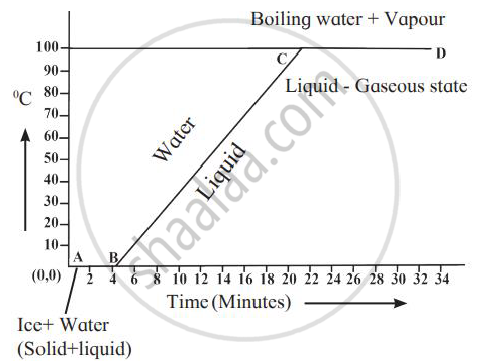Advertisements
Advertisements
Question
Explain the following:
The heat supplied to a substance during it change of state, does not cause any rise in its temperature.
Solution
Heat supplied to a substance during its change of state, does not cause any rise in its temperature because this is latent heat of phase change which is required to change the phase only.
APPEARS IN
RELATED QUESTIONS
State the effect of an increase of impurities on the melting point of ice.
What is the energy absorbed during the phase change called?
Write the approximate value of specific latent heat of ice.
A refrigerator converts 100g of water at 20℃ to ice at – 10℃ in 73.5 min. Calculate the average rate of heat extraction in watt. The specific heat capacity of water is 4.2 J kg-1 K-1, specific latent heat of ice is 336 J g-1 and the specific heat capacity of ice is 2.1 J kg-1 K-1.
Liquid ammonia is used in ice factory for making ice from water. If water at 20°C is to be converted into 2 kg ice at 0°C, how many grams of ammonia are to be evaporated? (Given: The latent heat of vaporization of ammonia = 341 cal/g)
Explain the following temperature vs time graph.

What do you mean by the statement?
'The specific latent heat capacity of fusion of ice is 336 J per g'?
What is the name given to the energy absorbed during a phase change?
A substance changes from its solid state to the liquid state when heat is supplied to it. What name is given to heat absorbed by the substance.
Explain the meaning of the term latent heat. State its S. I. unit.
Why does weather become pleasant when it starts freezing in cold countries?
State two advantages of the high specific latent heat capacity of steam, which is about 226 × 104 J/kg?
What observation you will record and how will you determine the specific latent heat of fusion of ice?
When ice is converted into water : constant temperature : : before the water evaporates : _______
Match the columns.
| Column A | Column B |
| 1) Specific latent heat of fusion | a) Air saturated with vapour |
| 2) Specific latent heat of vaporisation | b) Solid converts into liquid |
| 3) Dew point temperature | c) liquid converts into gas |
Match the columns.
| Column A | Column B |
| 1) Absolute humidity | a) J or cal |
| 2) Latent heat | b) J/kg °C |
| 3) Specific heat capacity | c) kJ/kg |
| 4) Heat | d) no unit |
| e) kg/m3 |
Define specific latent heat capacity
Specific latent heat L = ______.
600 g of copper at 50°C is mixed with lOOOg water at 20°C. Find the final temperature of the mixture. The specific heat capacity of copper is 0.4 Jg-1°C-1 and that of water is 4.2 Jg-1°C-1
